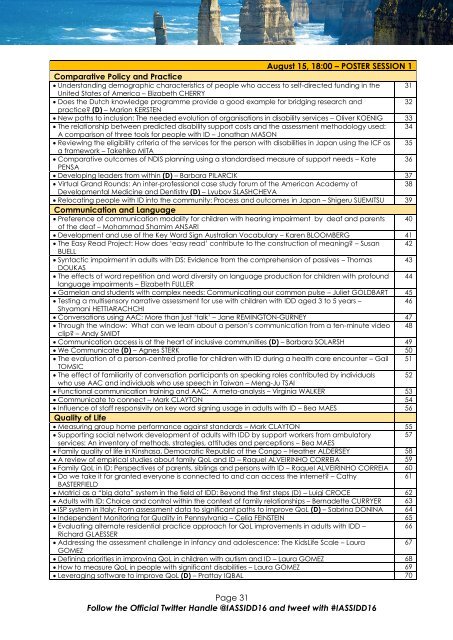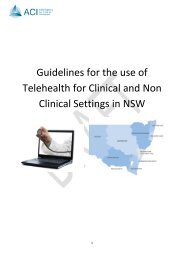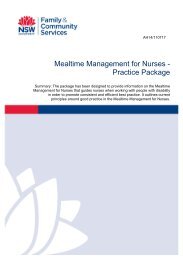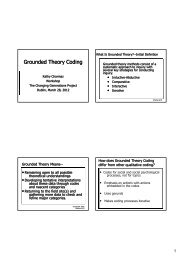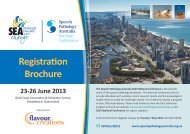Official Programme
ProgrammeBook_Final_25July2016
ProgrammeBook_Final_25July2016
You also want an ePaper? Increase the reach of your titles
YUMPU automatically turns print PDFs into web optimized ePapers that Google loves.
DAILY SCHEDULES<br />
August 15, 18:00 – POSTER SESSION 1<br />
Comparative Policy and Practice<br />
Understanding demographic characteristics of people who access to self-directed funding in the 31<br />
United States of America – Elizabeth CHERRY<br />
Does the Dutch knowledge programme provide a good example for bridging research and<br />
32<br />
practice? (D) – Marion KERSTEN<br />
New paths to inclusion: The needed evolution of organisations in disability services – Oliver KOENIG 33<br />
The relationship between predicted disability support costs and the assessment methodology used: 34<br />
A comparison of three tools for people with ID – Jonathan MASON<br />
Reviewing the eligibility criteria of the services for the person with disabilities in Japan using the ICF as 35<br />
a framework – Takehiko MITA<br />
Comparative outcomes of NDIS planning using a standardised measure of support needs – Kate 36<br />
PENSA<br />
Developing leaders from within (D) – Barbara PILARCIK 37<br />
Virtual Grand Rounds: An inter-professional case study forum of the American Academy of<br />
38<br />
Developmental Medicine and Dentistry (D) – Lyubov SLASHCHEVA<br />
Relocating people with ID into the community: Process and outcomes in Japan – Shigeru SUEMITSU 39<br />
Communication and Language<br />
Preference of communication modality for children with hearing impairment by deaf and parents 40<br />
of the deaf – Mohammad Shamim ANSARI<br />
Development and use of the Key Word Sign Australian Vocabulary – Karen BLOOMBERG 41<br />
The Easy Read Project: How does ‘easy read’ contribute to the construction of meaning? – Susan 42<br />
BUELL<br />
Syntactic impairment in adults with DS: Evidence from the comprehension of passives – Thomas 43<br />
DOUKAS<br />
The effects of word repetition and word diversity on language production for children with profound 44<br />
language impairments – Elizabeth FULLER<br />
Gamelan and students with complex needs: Communicating our common pulse – Juliet GOLDBART 45<br />
Testing a multisensory narrative assessment for use with children with IDD aged 3 to 5 years –<br />
46<br />
Shyamani HETTIARACHCHI<br />
Conversations using AAC: More than just ‘talk’ – Jane REMINGTON-GURNEY 47<br />
Through the window: What can we learn about a person’s communication from a ten-minute video 48<br />
clip? – Andy SMIDT<br />
Communication access is at the heart of inclusive communities (D) – Barbara SOLARSH 49<br />
We Communicate (D) – Agnes STERK 50<br />
The evaluation of a person-centred profile for children with ID during a health care encounter – Gail 51<br />
TOMSIC<br />
The effect of familiarity of conversation participants on speaking roles contributed by individuals 52<br />
who use AAC and individuals who use speech in Taiwan – Meng-Ju TSAI<br />
Functional communication training and AAC: A meta-analysis – Virginia WALKER 53<br />
Communicate to connect – Mark CLAYTON 54<br />
Influence of staff responsivity on key word signing usage in adults with ID – Bea MAES 56<br />
Quality of Life<br />
Measuring group home performance against standards – Mark CLAYTON 55<br />
Supporting social network development of adults with IDD by support workers from ambulatory 57<br />
services: An inventory of methods, strategies, attitudes and perceptions – Bea MAES<br />
Family quality of life in Kinshasa, Democratic Republic of the Congo – Heather ALDERSEY 58<br />
A review of empirical studies about family QoL and ID – Raquel ALVEIRINHO CORREIA 59<br />
Family QoL in ID: Perspectives of parents, siblings and persons with ID – Raquel ALVEIRINHO CORREIA 60<br />
Do we take it for granted everyone is connected to and can access the internet? – Cathy<br />
61<br />
BASTERFIELD<br />
Matrici as a “big data” system in the field of IDD: Beyond the first steps (D) – Luigi CROCE 62<br />
Adults with ID: Choice and control within the context of family relationships – Bernadette CURRYER 63<br />
ISP system in Italy: From assessment data to significant paths to improve QoL (D) – Sabrina DONINA 64<br />
Independent Monitoring for Quality in Pennsylvania – Celia FEINSTEIN 65<br />
Evaluating alternate residential practice approach for QoL improvements in adults with IDD –<br />
66<br />
Richard GLAESSER<br />
Addressing the assessment challenge in infancy and adolescence: The KidsLife Scale – Laura<br />
67<br />
GOMEZ<br />
Defining priorities in improving QoL in children with autism and ID – Laura GOMEZ 68<br />
How to measure QoL in people with significant disabilities – Laura GOMEZ 69<br />
Leveraging software to improve QoL (D) – Prattay IQBAL 70<br />
Page 31<br />
Follow the <strong>Official</strong> Twitter Handle @IASSIDD16 and tweet with #IASSIDD16


